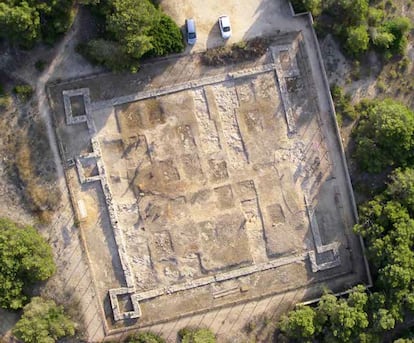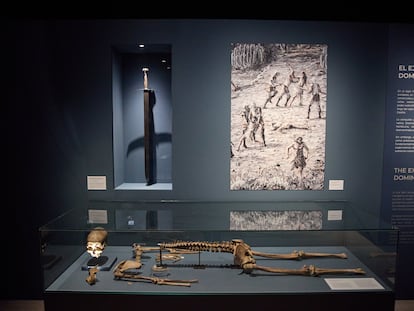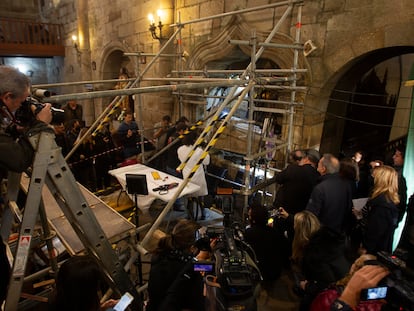How an act of revenge halted construction of a Roman fort on a small Spanish island
Archaeologists took 44 years to discover who began to build an expensive ‘castellum’ in Formentera, the least strategic of the Balearic Islands, and why


It has taken archaeologists 44 years to answer the question of who ordered the construction of a large Roman castellum in the center of the small Spanish island of Formentera, in the Balearic archipelago, instead of on the nearby and more strategic Ibiza, which is seven times larger. The solution to the mystery was found more than 1,500 kilometers away, on the Milvian Bridge (north of Rome), where in the year 312 A.D. the troops of the emperors Constantine and Maxentius clashed. Now, the study Can Blai, una fortificación tardoantigua de Ebusus (available only in Spanish), coordinated by the archaeologists Jordi H. Fernández Gómez and Ricardo González Villaescusa, offers a possible answer to the question: revenge.
Excavation of a Roman-era fortification on the Can Blai site began in 1979. The construction is located almost in the center of the island and sits at an altitude of 82 feet above sea level. The fort has views on the north and south coasts of Formentera, as well as the east of Ibiza, allowing approaching ships to be monitored. It was a quadrangular enclosure measuring about 130 feet per side. It had towers on each of its four corners, as well as a fifth that protected the postern or entrance.
Given its dimensions, it had the capacity to house a garrison of between 80 and 150 soldiers, but it was unknown if it had ever been completed because only the foundations and a few courses of ashlar (dressed stone) remain. At first, experts felt the lack of architectural materials at the site was due to one of two reasons. The first is that it was the result of centuries of plunder — an idea that the latest research rejects based on two pieces of information: all the remaining walls are exactly the same height, and the opening of the access door does not have foundations. The second reason basically amounts to the same: the work was never completed. “We had the sensation of excavating an unfinished work,” says Jordi H. Fernández.

The fort’s foundations range between 38 and 39 inches in height. And the ashlar stones are arranged on top of it. The exterior and interior walls are made of sandstone and were filled with mortar to give consistency to the 3.5 feet thick perimeter walls.
Therefore, since it was not inhabited, “archaeological interventions have made it possible to confirm the great poverty of found materials. In fact, there are no metallic elements, since not even the use of a detector has allowed us to obtain a single fragment of metal,” explains Ricardo González Villaescusa, a professor of archeology at the University of Paris Nanterre. He is also one of the experts who participated in this publication by the Archaeological Museum of Ibiza and Formentera and the regional government of the Balearic Islands’ Department of Tourism, Culture, and Sports.
The site’s greatest treasure, however, is its architectural structures. It is an almost complete enclosure, with its towers, to which are added an internal subdivision of the fortification and two ceramic finds. The dividing wall was intended to form a parade ground. In addition, it served as a buttress for the perimeter walls and support for the upper floor or gallery, which could be used as a service corridor for tower lookouts and troops to move around in the event of a siege.
Deterrence
In 2015, a fragment of an amphora from the 4th century was found that allowed experts to date the castellum to the first years of that century. Archaeologists believe that Can Blai was part of a surveillance system that included the watchtowers of Sa Muradeta and Torre des Pi des Català, which are also on Formentera.
The three fortifications were located in strategic locations to cover the defensive system’s weak areas: inlets, landing places and blind spots. “The objective was not only to prevent a landing, but also to avoid any attempt to seize the ships that were anchored, as well as to raise the alarm to other posts in case a ship was sighted,” the publication indicates.
“In short, the mere presence of the fortress was an element of deterrence which was visible from any point of arrival. [It was] a pavilion indicating the presence of a power, whatever it may be.” Furthermore, the soldiers of the castellum could move in case of emergency to delay or prevent a landing. “The city of Ebusus [Ibiza] and its port were undoubtedly the object of protection. The function of the fortification was to prevent any army from turning the small island of Pitiusas [Formentera] into its base of operations. Well supplied with water, wood, and game, the island could become a fundamental bridgehead for organizing expeditions against Ibiza, but also towards the Hispanic coasts,” adds González Villaescusa.
Only an emperor could authorize it
The Corpus Iuris ciuilis (6th century compilation of Roman Law) makes it clear that any new defensive work, intervention on the walls, or their restoration had to be financed by the city and that they also required express authorization from the emperor, after consultation with the provincial governor. Therefore, Can Blai could only be the work of the municipality of Ibiza (which financed it) with the approval of the emperor to defend itself against possible threats. “But what were the threats that could motivate such an important disbursement and required imperial authorization?” the authors of the study ask. No ancient sources speak of any conflicts at the time of its construction. The nearest operations were in the year 306 A. D. and were the made by Constantine, who dominated Hispania, against the pirates. But the coins of the period that have been found mostly in Ibiza do not feature Constantine, but Maxentius (72.7%) and “must be attributed to the presence of his troops.”
The Balearic Islands occupied a border position between the territories controlled by each of the two emperors in Western Europe and North Africa. Therefore, Maxentius was able to authorize construction to control Constantine’s fleet. But the latter defeated him on October 28, 312 A.D. in the battle of the Milvian Bridge in northern Rome. That is, Maxentius drowned in the waters of the Tiber while the castellum that he had ordered to be constructed in Formentera was still being built.
The legacy of the defeated emperor was then subjected to what is known as damnatio memoriae, the elimination of any pictorial, sculptural or monumental remains that could preserve the memory of his name, including a square fort 130 feet by 130 feet that the soldiers were building among the lush pine forests of Formentera.
Sign up for our weekly newsletter to get more English-language news coverage from EL PAÍS USA Edition
Tu suscripción se está usando en otro dispositivo
¿Quieres añadir otro usuario a tu suscripción?
Si continúas leyendo en este dispositivo, no se podrá leer en el otro.
FlechaTu suscripción se está usando en otro dispositivo y solo puedes acceder a EL PAÍS desde un dispositivo a la vez.
Si quieres compartir tu cuenta, cambia tu suscripción a la modalidad Premium, así podrás añadir otro usuario. Cada uno accederá con su propia cuenta de email, lo que os permitirá personalizar vuestra experiencia en EL PAÍS.
¿Tienes una suscripción de empresa? Accede aquí para contratar más cuentas.
En el caso de no saber quién está usando tu cuenta, te recomendamos cambiar tu contraseña aquí.
Si decides continuar compartiendo tu cuenta, este mensaje se mostrará en tu dispositivo y en el de la otra persona que está usando tu cuenta de forma indefinida, afectando a tu experiencia de lectura. Puedes consultar aquí los términos y condiciones de la suscripción digital.
More information
Archived In
Últimas noticias
Most viewed
- Sinaloa Cartel war is taking its toll on Los Chapitos
- Oona Chaplin: ‘I told James Cameron that I was living in a treehouse and starting a permaculture project with a friend’
- Reinhard Genzel, Nobel laureate in physics: ‘One-minute videos will never give you the truth’
- Why the price of coffee has skyrocketed: from Brazilian plantations to specialty coffee houses
- Silver prices are going crazy: This is what’s fueling the rally










































